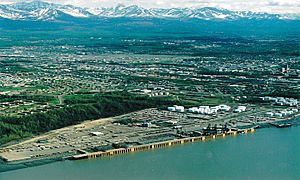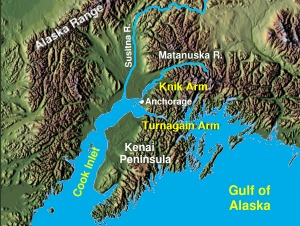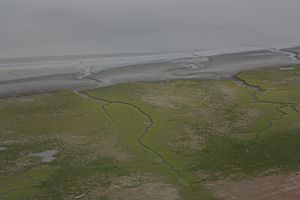Knik Arm facts for kids
The Knik Arm is a long, narrow waterway in Alaska. It is like a natural highway that leads into the northwestern part of the Gulf of Alaska. Think of it as one of two "arms" of a larger body of water called Cook Inlet. The other arm is called Turnagain Arm. The Knik Arm is an important place because the Port of Anchorage, a busy shipping hub, is located right on its shores. Also, the huge Knik Glacier melts and its water flows into the Knik Arm.
What Does "Knik" Mean?
The name "Knik" comes from an old word. It comes from igniq, which is an Iñupiaq word meaning "fire." Over time, people wrote the name in many different ways, like Kinik, Kneep, and Kweek.
Where is Knik Arm Located?
Knik Arm starts at the northern edge of Cook Inlet, very close to the city of Anchorage. From there, it stretches north and east. It's about 15 miles (24 kilometers) long. At its far end, it receives water from the Matanuska River.
To the west of Knik Arm, you'll find the wide delta of the Susitna River. This is the biggest river that flows into Cook Inlet. At the very top of Knik Arm, where the Knik River meets the tide, there used to be a village called Knik. Other rivers and creeks that flow into Knik Arm include Ship Creek, Eagle River, Peter's Creek, Eklutna River, and Fish Creek. Much of the land between Knik Arm and the Susitna River is drained by the Little Susitna River.
A Look at Knik Arm's Past
Long ago, there were native villages like Knakatnuk and Nitak right on the shores of Knik Arm. These were important places for the local people.
In 1964, a very powerful earthquake hit Alaska. This earthquake caused a lot of damage to many parts of Anchorage that were close to Knik Arm. It even damaged the downtown area.
Today, there are plans and ideas for how people can use Knik Arm. One idea was the Knik Arm Bridge. This bridge would be about 2 miles (3.2 kilometers) long. It would connect Point MacKenzie on the west side to Anchorage on the east side. Another idea was the Knik Arm ferry. This ferry would carry passengers and cars across the arm all year round. It was planned to use a special type of boat called the M/V Susitna.





